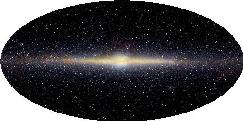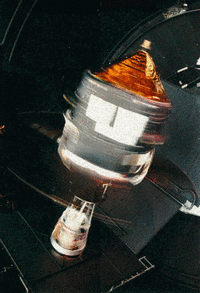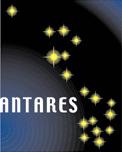Weighing the Milky Way DiskThe weight of the Milky Way disk is on a firmer basis than ever before thanks to ANTARES astronomers, who measured it using one of the world's oldest telescopes together with and one of the most accurate space satellites.
The stars in our Milky Way galaxy form a disk, which we see as a thin band of stars across the sky. The disk is about 100,000 light years across and a few 1000 light years thick. For more than a hundred years it has been known that the stars are moving up and down in the disk; indeed it is this very motion which gives the Milky Way its thickness.
Take one of the stars near the Sun which happens to be moving upwards; if we could wait long enough, and track its orbit going up once and down again, we could measure the weight of all the stars near the Sun, because it is the weight, or gravity, of all these other stars which has pulled it back again. The problem is that, unfortunately we'd have to wait a few dozen million years!
Luckily, there is an alternative; take statistics of how a few hundred stars are moving in the Milky Way at this very moment --- from the statistical motions of these stars the weight of the Milky Way can be measured. Now, Chris Flynn of Tuorla Observatory and Johan Holmberg of Lund Observatory have combined data taken on one hand with the 9 inch, 90 year old brass and clockwork Oddie telescope at Mount Stromlo Observatory and on the other hand with the state-of-the-art European Space Agency's Hipparcos satellite. Photos taken with the Oddie telescope were used to find the stars they needed, while the Hipparcos satellite measured the distances to the stars more accurately than ever before.
"The results from the Oddie Telescope where enough to give us a first guess of the Milky Way's weight, but we needed the Hipparcos satellite to be sure" said team leader and Academy of Finland Senior Researcher Chris Flynn. "Because of the accurate Hipparcos results, we have put the weight of the Milky Way on a firm basis" said Flynn. Our study shows that the Milky Way disk weighs in at about 40 billion times heavier than the Sun.
The Oddie telescope was destroyed in bushfires which swept across Mount Stromlo Observatory in January 2003.
For further information:
Chris Flynn
Väisäläntie 20FIN-21500 Piikkiö
Finland
Tel: +358 (0)2 2744244
Fax: +358 (0)2 2433767email: cflynn@astro.utu.fi

The DIRBE view of our Milky Way Galaxy showing the disk (seen edge on) and the central bulge. The Sun is located some 30,000 light years from the central region, so that from our vantage point on the Earth we get this spectacular view of our own galaxy 'looking in'.

The European Space Agency's Hipparcos satellite has measured distances and spatial motions of 125,000 nearby stars with a huge increase in precision compared to a previous 100 years of astronomical observations done with telescopes on the Earth.

Research supported by the ANTARES program of the Academy of Finland